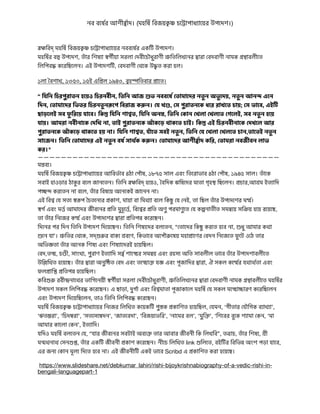аҰЁаҰ¬ аҰ¬аҰ°а§ҚаҰ·аҘӨ (аҰ®аҰ№аҰ°а§ҚаҰ·аҰҝ аҰ¬аҰҝаҰңа§ҹаҰ•а§ғаҰ·а§ҚаҰЈ аҰҡаҰҹа§ҚаҰҹа§ӢаҰӘаҰҫаҰ§а§ҚаҰҜаҰҫа§ҹа§ҮаҰ° аҰүаҰӘаҰҰа§ҮаҰ¶аҰҫаҰ¬аҰІа§Җ аҰҘа§ҮаҰ•а§Ү аҰёаҰӮаҰ—а§ҚаҰ°аҰ№аҰҝаҰӨаҘӨ)
- 1. аҰЁаҰ¬ аҰ¬ аҰ°а§ҚаҰ·а§Ү аҰ° аҰҶаҰ¶а§Җ аҰ°а§ҚаҰ¬а§ҚаҰ¬аҰҫ аҰҰаҘӨ (аҰ®аҰ№ аҰ°а§ҚаҰ·аҰҝ аҰҝаҰ¬аҰңа§ҹ аҰ•а§ғ аҰ·а§ҚаҰЈ аҰҡ аҰҹа§ҚаҰҹа§Ӣ аҰӘаҰҫ аҰ§а§ҚаҰҜаҰҫ а§Үа§ҹаҰ° аҰүаҰӘа§ҮаҰҰаҰ¶аҘӨ) аҰ¬а§ҚаҰ° аҰ№а§ҚаҰ® аҰҝаҰ¬аҰҰа§Қ вҖҢ аҰ®аҰ№ аҰ°а§ҚаҰ·аҰҝ аҰҝаҰ¬аҰңа§ҹ аҰ•а§ғ аҰ·а§ҚаҰЈ аҰҡ аҰҹа§ҚаҰҹа§Ӣ аҰӘаҰҫ аҰ§а§ҚаҰҜаҰҫ а§Үа§ҹаҰ° аҰЁаҰ¬аҰ¬ аҰ°а§ҚаҰ·а§Ү аҰ° аҰҸаҰ• аҰҹаҰҝ аҰүаҰӘа§ҮаҰҰаҰ¶аҘӨ аҰ®аҰ№ аҰ°а§ҚаҰ·аҰҝ аҰ° аҰ¬ аҰ№а§Ғ аҰүаҰӘа§ҮаҰҰаҰ¶, аҰӨаҰҫаҰҒ аҰ° аҰҝаҰ¶ аҰ·а§ҚаҰҜаҰҫ аҰёа§ҚаҰ¬ аҰ°а§ҚаҰ—а§Җ а§ҹаҰҫ аҰёаҰ°аҰІаҰҫ аҰҰа§Ү аҰ¬а§Җ аҰҡа§Ң аҰ§а§Ғ аҰ°аҰҫаҰЈа§Җ аҰ¶а§ҚаҰ°а§Ғ аҰҝаҰӨаҰҝаҰІаҰ–а§ҮаҰЁаҰ° аҰҰа§ҚаҰ¬аҰҫ аҰ°аҰҫ аҰ¬а§Ү аҰҰаҰ¬аҰҫаҰЈа§Җ аҰЁаҰҫаҰ®аҰ• аҰ—а§ҚаҰ° аҰЁа§ҚаҰҘаҰҫ аҰ¬аҰІа§Җа§ҮаҰӨ аҰҝаҰІаҰҝаҰӘаҰ¬ аҰҰа§ҚаҰ§ аҰ•а§ҮаҰ°аҰҝаҰӣа§ҮаҰІаҰЁаҘӨ аҰҸаҰҮ аҰүаҰӘа§ҮаҰҰаҰ¶ аҰҹаҰҝ , аҰ¬а§Ү аҰҰаҰ¬аҰҫаҰЈа§Җ аҰҘа§Ү а§ҮаҰ• аҰү аҰҰа§ҚаҰ§а§ғ аҰӨ аҰ•аҰ°аҰҫ аҰ№аҰІаҘӨ ১аҰІаҰҫ аҰ¬а§Ҳ аҰ¶аҰҫаҰ–, ১৩৫а§Ұ, ১৫аҰҮ аҰҸ аҰӘа§ҚаҰ°аҰҝ аҰІ ১а§Ҝа§Ә৩, аҰ¬а§ғ аҰ№ аҰёа§ҚаҰӘ аҰҝаҰӨаҰ¬аҰҫаҰ° аҰӘа§ҚаҰ°аҰҫ а§ҮаҰӨаҘӨ вҖң аҰҝаҰҜаҰҝаҰЁ аҰҝаҰҡаҰ°аҰӘа§ҒаҰ°аҰҫаҰӨаҰЁ аҰ№а§Үа§ҹаҰ“ аҰҝаҰҡаҰ°аҰЁаҰ¬а§ҖаҰЁ, аҰҝаҰӨаҰҝаҰЁ аҰҶаҰң аҰ¶а§Ғ аҰӯ аҰЁаҰ¬аҰ¬ аҰ°а§ҚаҰ·а§Ү аҰӨа§Ӣ аҰ®аҰҫа§ҮаҰҰаҰ° аҰЁ аҰӨа§Ғ аҰЁ аҰ… аҰӯа§ҚаҰҜа§Ғ аҰҰа§ҹ, аҰЁ аҰӨа§Ғ аҰЁ аҰҶаҰЁ аҰЁа§ҚаҰҰ аҰҸа§ҮаҰЁ аҰҝаҰҰаҰЁ, аҰӨа§Ӣ аҰ®аҰҫа§ҮаҰҰаҰ° аҰҝаҰӯаҰӨаҰ° аҰҝаҰҡаҰ°аҰЁ аҰӨа§Ғ аҰЁ аҰ°а§Ӯ а§ҮаҰӘ аҰҝаҰ¬аҰ°аҰҫаҰң аҰ• аҰ°а§Ғ аҰЁаҘӨ аҰҜа§Ү аҰ– аҰЈа§ҚаҰЎ , аҰёа§Ү аҰӘа§ҒаҰ°аҰҫаҰӨаҰЁа§ҮаҰ• аҰ§а§ҮаҰ° аҰ°аҰҫаҰ–а§ҮаҰӨ аҰҡаҰҫа§ҹ; аҰёа§Ү аҰӯаҰҫа§ҮаҰ¬, аҰҸаҰҮ аҰҹаҰҝ аҰӣаҰҫа§ңа§ҮаҰІаҰҮ аҰёаҰ¬ аҰ«а§Ғ аҰҝаҰ°а§Үа§ҹ аҰҜаҰҫа§ҮаҰ¬аҘӨ аҰҝаҰ• аҰЁа§ҚаҰӨа§Ғ аҰҝаҰҜаҰҝаҰЁ аҰ¶аҰҫ аҰ¶а§ҚаҰ¬ аҰӨ, аҰҝаҰҜаҰҝаҰЁ аҰ…аҰЁ аҰЁа§ҚаҰӨ , аҰҝаҰӨаҰҝаҰЁ аҰ•а§Ӣ аҰЁ аҰ–а§Ү аҰІаҰҫ аҰ–а§Ү аҰІа§ҮаҰӨ аҰ—а§Ү а§ҮаҰІаҰҮ, аҰёаҰ¬ аҰЁ аҰӨа§Ғ аҰЁ аҰ№а§Үа§ҹ аҰҜаҰҫа§ҹаҘӨ аҰҶаҰ®аҰ°аҰҫ аҰЁаҰ¬а§ҖаҰЁаҰҫа§ҮаҰ• аҰҰа§Ү аҰҝаҰ– аҰЁаҰҫ, аҰӨаҰҫаҰҮ аҰӘа§ҒаҰ°аҰҫаҰӨаҰЁа§ҮаҰ• аҰҶ аҰҒ аҰ•а§Үа§ң аҰҘаҰҫаҰ•а§ҮаҰӨ аҰҡаҰҫаҰҮаҘӨ аҰҝаҰ• аҰЁа§ҚаҰӨа§Ғ аҰҸаҰҮ аҰҝаҰҡаҰ°аҰЁаҰ¬а§ҖаҰЁаҰҫа§ҮаҰ• аҰҰа§Ү аҰ–а§ҮаҰІ аҰҶаҰ° аҰӘа§ҒаҰ°аҰҫаҰӨаҰЁа§ҮаҰ• аҰҶ аҰҒ аҰ•а§Үа§ң аҰҘаҰҫаҰ•а§ҮаҰӨ аҰ№а§ҹ аҰЁаҰҫаҘӨ аҰҝаҰҜаҰҝаҰЁ аҰ¶аҰҫ аҰ¶а§ҚаҰ¬ аҰӨ, аҰҜаҰҫаҰҒ а§ҮаҰӨ аҰёаҰ¬аҰҮ аҰЁ аҰӨа§Ғ аҰЁ, аҰҝаҰӨаҰҝаҰЁ аҰҜа§Ү аҰ–а§Ү аҰІаҰҫ аҰ–а§Ү аҰІа§ҮаҰӨ аҰҡаҰҫаҰЁ,аҰӨаҰҫа§ҮаҰӨаҰҮ аҰЁ аҰӨа§Ғ аҰЁ аҰёаҰҫа§ҮаҰңаҰЁаҘӨ аҰҝаҰӨаҰҝаҰЁ аҰӨа§Ӣ аҰ®аҰҫа§ҮаҰҰаҰ° аҰҸаҰҮ аҰЁ аҰӨа§Ғ аҰЁ аҰ¬ аҰ°а§ҚаҰ· аҰёаҰҫ аҰ°а§ҚаҰҘ аҰ• аҰ• аҰ°а§Ғ аҰЁаҘӨ аҰӨа§Ӣ аҰ®аҰҫа§ҮаҰҰаҰ° аҰҶаҰ¶а§Җ аҰ°а§ҚаҰ¬а§ҚаҰ¬аҰҫ аҰҰ аҰ•аҰҝаҰ°, аҰӨа§Ӣ аҰ®аҰ°аҰҫ аҰЁаҰ¬аҰңа§ҖаҰ¬аҰЁ аҰІаҰҫаҰӯ аҰ•аҰ°аҘӨ" вҖ”вҖ”вҖ”вҖ”вҖ”вҖ”вҖ”вҖ”вҖ”вҖ”вҖ”вҖ”вҖ”вҖ”вҖ”вҖ”вҖ”вҖ”вҖ”вҖ”вҖ”вҖ”вҖ”вҖ”вҖ”вҖ”вҖ”вҖ”вҖ”вҖ”вҖ”вҖ”вҖ”вҖ”вҖ”вҖ”вҖ”вҖ”вҖ”вҖ”вҖ”вҖ” аҰ® аҰЁа§ҚаҰӨ аҰ¬а§ҚаҰҜ аҘӨ аҰ®аҰ№ аҰ°а§ҚаҰ·аҰҝ аҰҝаҰ¬аҰңа§ҹ аҰ•а§ғ аҰ·а§ҚаҰЈ аҰҡ аҰҹа§ҚаҰҹа§Ӣ аҰӘаҰҫ аҰ§а§ҚаҰҜаҰҫ а§Үа§ҹаҰ° аҰҶаҰҝаҰ¬ аҰ°а§ҚаҰӯаҰҫ аҰ¬ а§ӘаҰ аҰҫ аҰӘа§Ң аҰ·, ১৮а§ӯ৫ аҰёаҰҫаҰІ аҰҸаҰ¬аҰӮ аҰҝаҰӨ аҰ°а§Ӣ аҰӯаҰҫаҰ¬ а§ӘаҰ аҰҫ аҰӘа§Ң аҰ·, ১а§Ҝа§Ә৫ аҰёаҰҫаҰІаҘӨ аҰӨаҰҫаҰҒ а§ҮаҰ• аҰёаҰ¬аҰҫаҰҮ аҰ№аҰҫаҰ“а§ңаҰҫаҰ° аҰ аҰҫ аҰ•а§Ғ аҰ° аҰ¬а§ҮаҰІ аҰңаҰҫаҰЁа§ҮаҰӨаҰЁаҘӨ аҰҝаҰӨаҰҝаҰЁ аҰ¬а§ҚаҰ° аҰ№а§ҚаҰ® аҰҝаҰ¬аҰҰа§Қ вҖҢ аҰ№а§Үа§ҹаҰ“, аҰ¬а§Ҳ аҰҝаҰҰаҰ• аҰӢаҰҝаҰ·а§ҮаҰҰаҰ° аҰ® аҰӨа§Ӣ аҰ—а§ғаҰ№ аҰёа§ҚаҰҘ аҰҝаҰӣа§ҮаҰІаҰЁаҘӨ аҰӘа§ҚаҰ° аҰҡаҰҫаҰ°,аҰҶ аҰ¶а§ҚаҰ° аҰ® аҰҮ аҰӨа§ҚаҰҜаҰҫ аҰҝаҰҰ аҰӘ аҰҡа§ҚаҰӣ аҰЁа§ҚаҰҰ аҰ•аҰ°а§ҮаҰӨаҰЁ аҰЁаҰҫ аҰ¬а§ҮаҰІ, аҰӨаҰҫаҰҒ аҰ° аҰҝаҰ¬аҰ·а§Үа§ҹ аҰ…а§ҮаҰЁа§ҮаҰ•аҰҮ аҰңаҰҫа§ҮаҰЁаҰЁ аҰЁаҰҫаҘӨ аҰҸаҰҮ аҰҝаҰ¬ аҰ¶а§ҚаҰ¬ аҰҜа§Ү аҰё аҰӨа§ҚаҰҜ аҰёа§ҚаҰ¬ аҰ°а§Ӯ аҰӘ аҰҡа§Ҳ аҰӨ аҰЁа§ҚаҰҜа§Ү аҰ° аҰӘа§ҚаҰ° аҰ•аҰҫаҰ¶, аҰ®аҰҫа§ҹаҰҫ аҰ¬аҰҫ аҰҝаҰ® аҰҘа§ҚаҰҜаҰҫ аҰ¬а§ҮаҰІ аҰҝаҰ• аҰӣа§Ғ аҰҜа§Ү аҰЁа§Ү аҰҮ, аҰӨаҰҫ аҰҝаҰӣаҰІ аҰӨаҰҫаҰҒ аҰ° аҰүаҰӘа§ҮаҰҰа§ҮаҰ¶аҰ° аҰ® аҰ°а§ҚаҰ®а§ҚаҰ® аҘӨ аҰёа§ҚаҰ¬ аҰ°а§ҚаҰ— аҰҸаҰ¬аҰӮ аҰ® аҰ°а§ҚаҰӨа§ҚаҰӨ аҰҶаҰ®аҰҫа§ҮаҰҰаҰ° аҰңа§ҖаҰ¬а§ҮаҰЁаҰ° аҰӘа§ҚаҰ° аҰҝаҰӨ аҰ®а§Ғ аҰ№а§Ӯ аҰ°а§ҚаҰӨа§ҚаҰӨа§Ү , аҰҝаҰ¬ аҰ¶а§ҚаҰ¬а§Ү аҰ° аҰӘа§ҚаҰ° аҰҝаҰӨ аҰ…аҰЈа§Ғ аҰӘаҰ°аҰ®аҰҫаҰЈа§Ға§ҮаҰӨ аҰҜа§Ү аҰ• аҰІа§ҚаҰӘ аҰЁаҰҫаҰӨа§ҖаҰӨ аҰёаҰ® аҰЁа§ҚаҰ¬ а§Үа§ҹ аҰё аҰ•а§ҚаҰ°аҰҝ а§ҹ аҰ№а§Үа§ҹ аҰ°а§Үа§ҹа§ҮаҰӣ, аҰӨаҰҫ аҰӨаҰҫаҰҒ аҰ° аҰҝаҰЁа§ҮаҰңаҰ° аҰ• аҰ°а§ҚаҰ®а§ҚаҰ® аҰҸаҰ¬аҰӮ аҰүаҰӘа§ҮаҰҰа§ҮаҰ¶аҰ° аҰҰа§ҚаҰ¬аҰҫ аҰ°аҰҫ аҰӘа§ҚаҰ° аҰҝаҰӨаҰӘ аҰЁа§ҚаҰЁ аҰ•а§ҮаҰ°а§ҮаҰӣаҰЁаҘӨ аҰҝаҰҰа§ҮаҰЁаҰ° аҰӘаҰ° аҰҝаҰҰаҰЁ аҰҝаҰӨаҰҝаҰЁ аҰүаҰӘа§ҮаҰҰаҰ¶ аҰҝаҰҰа§Үа§ҹа§ҮаҰӣаҰЁаҘӨ аҰҝаҰӨаҰҝаҰЁ аҰҝаҰ¶ аҰ·а§ҚаҰҜ а§ҮаҰҰаҰ° аҰ¬аҰІа§ҮаҰӨаҰЁ, вҖң аҰӨа§Ӣ а§ҮаҰҰаҰ° аҰҝаҰ• аҰӣа§Ғ аҰ•аҰ°а§ҮаҰӨ аҰ№а§ҮаҰ¬ аҰЁаҰҫ, аҰ¶а§Ғ аҰ§а§Ғ аҰҶаҰ®аҰҫаҰ° аҰ•аҰҘаҰҫ аҰ¶а§Ғ а§ҮаҰЁ аҰҜаҰҫвҖҷаҘӨ аҰ¶а§ҚаҰ°а§Ғ аҰҝаҰӨаҰ° аҰҘа§Ү а§ҮаҰ•, аҰёаҰҰа§Қ вҖҢаҰ—а§Ғ аҰ°а§Ғ аҰ° аҰ¬аҰҫ аҰ•а§ҚаҰҜ аҰ¶а§ҚаҰ° аҰ¬а§ҮаҰЈ, аҰҝаҰ•аҰӯаҰҫа§ҮаҰ¬ аҰ… аҰӘа§Ң аҰ°а§Ғ а§ҮаҰ·а§ҹ аҰ®аҰ№аҰҫ аҰӘа§ҚаҰ°аҰҫ а§ҮаҰЈаҰ° аҰ¬а§Ү аҰҰаҰЁ аҰҝаҰЁа§ҮаҰңа§ҮаҰӨ аҰ«а§Ғ а§ҮаҰҹ аҰ“а§ҮаҰ аҰӨаҰҫаҰ° аҰ…аҰҝаҰӯ аҰңа§ҚаҰһ аҰӨаҰҫ аҰӨаҰҫаҰҒ аҰ° аҰ…а§ҮаҰЁаҰ• аҰҝаҰ¶ аҰ·а§ҚаҰҜ аҰҸаҰ¬аҰӮ аҰҝаҰ¶ аҰ·а§ҚаҰҜаҰҫ а§ҮаҰҰаҰ°аҰҮ аҰ№а§Үа§ҹаҰҝаҰӣаҰІаҘӨ аҰ¬а§Ү аҰҰ,аҰӨ аҰЁа§ҚаҰӨа§ҚаҰ° , аҰҡ аҰЈа§ҚаҰЎа§Җ , аҰёаҰҫаҰӮ аҰ–а§ҚаҰҜ , аҰӘа§ҒаҰ°аҰҫаҰЈ аҰҮ аҰӨа§ҚаҰҜаҰҫ аҰҝаҰҰ аҰё аҰ°а§ҚаҰ¬а§ҚаҰ¬ аҰ¶аҰҫ аҰёа§ҚаҰӨа§ҚаҰ°а§Ү аҰ° аҰёаҰ® аҰЁа§ҚаҰ¬ а§ҹ аҰҸаҰ¬аҰӮ аҰ°аҰ№ аҰёа§ҚаҰҜ аҰ…аҰҝаҰӨ аҰёаҰҫаҰ¬аҰІа§ҖаҰІ аҰӯаҰҫа§ҮаҰ¬ аҰӨаҰҫаҰҒ аҰ° аҰүаҰӘа§ҮаҰҰаҰ¶аҰҫаҰ¬аҰІа§Җа§ҮаҰӨ аҰү аҰІа§ҚаҰІаҰҝ аҰҝаҰ–аҰӨ аҰ№а§Үа§ҹа§ҮаҰӣаҘӨ аҰӨаҰҫаҰҒ аҰ° аҰҰа§ҚаҰ¬аҰҫ аҰ°аҰҫ аҰ…аҰЁа§Ғ аҰ·а§ҚаҰ аҰҝ аҰӨ аҰ¬а§Ү аҰҰ аҰҸаҰ¬аҰӮ аҰӨ аҰЁа§ҚаҰӨа§ҚаҰ°а§Ӣ аҰ•а§ҚаҰӨ аҰҜ аҰңа§ҚаҰһ аҰҸаҰ¬аҰӮ аҰӘа§ӮаҰңаҰҫаҰҝаҰҰаҰ° аҰҰа§ҚаҰ¬аҰҫ аҰ°аҰҫ, аҰҗ аҰёаҰ•аҰІ аҰ• аҰ°а§ҚаҰ®а§ҚаҰ®а§Ү аҰ° аҰҜаҰҘаҰҫ аҰ°а§ҚаҰҘ аҰӨаҰҫ аҰҸаҰ¬аҰӮ аҰ«аҰІ аҰӘа§ҚаҰ°аҰҫ аҰӘа§ҚаҰӨаҰҝ аҰӘа§ҚаҰ° аҰҝаҰӨаҰӘ аҰЁа§ҚаҰЁ аҰ№а§Үа§ҹаҰҝаҰӣаҰІаҘӨ аҰ•аҰҝаҰ¬ аҰ—а§Ғ аҰ°а§Ғ аҰ°аҰ¬а§Җ аҰЁа§ҚаҰҰа§ҚаҰ° аҰЁаҰҫа§ҮаҰҘаҰ° аҰӯаҰҫаҰҝаҰ—а§ҮаҰЁа§ҹа§Җ аҰёа§ҚаҰ¬ аҰ°а§ҚаҰ—а§Җ а§ҹаҰҫ аҰёаҰ°аҰІаҰҫ аҰҰа§Ү аҰ¬а§Җ аҰҡа§Ң аҰ§а§Ғ аҰ°аҰҫаҰЈа§Җ, аҰ¶а§ҚаҰ°а§Ғ аҰҝаҰӨаҰҝаҰІаҰ–а§ҮаҰЁаҰ° аҰҰа§ҚаҰ¬аҰҫ аҰ°аҰҫ аҰ¬а§Ү аҰҰаҰ¬аҰҫаҰЈа§Җ аҰЁаҰҫаҰ®аҰ• аҰ—а§ҚаҰ° аҰЁа§ҚаҰҘаҰҫ аҰ¬аҰІа§Җа§ҮаҰӨ аҰ®аҰ№ аҰ°а§ҚаҰ·аҰҝ аҰ° аҰүаҰӘа§ҮаҰҰаҰ¶ аҰёаҰ•аҰІ аҰҝаҰІаҰҝаҰӘаҰ¬ аҰҰа§ҚаҰ§ аҰ•а§ҮаҰ°а§ҮаҰӣаҰЁаҘӨ аҰҸ аҰӣаҰҫа§ңаҰҫ, аҰҰа§Ғ аҰ°а§ҚаҰ—аҰҫ аҰҸаҰ¬аҰӮ аҰҝаҰ¬ аҰ¶а§ҚаҰ¬ аҰ®аҰҫаҰӨаҰҫ аҰӘа§ӮаҰңаҰҫаҰ•аҰҫа§ҮаҰІ аҰ®аҰ№ аҰ°а§ҚаҰ·аҰҝ аҰҜа§Ү аҰёаҰ•аҰІ аҰ® аҰЁа§ҚаҰӨа§ҚаҰ°а§Ӣ аҰҡа§ҚаҰҡаҰҫ аҰ°аҰЈ аҰ•а§ҮаҰ°аҰҝаҰӣа§ҮаҰІаҰЁ аҰҸаҰ¬аҰӮ аҰүаҰӘа§ҮаҰҰаҰ¶ аҰҝаҰҰа§Үа§ҹаҰҝаҰӣа§ҮаҰІаҰЁ, аҰӨаҰҫаҰ“ аҰҝаҰӨаҰҝаҰЁ аҰҝаҰІаҰҝаҰӘаҰ¬ аҰҰа§ҚаҰ§ аҰ•а§ҮаҰ°а§ҮаҰӣаҰЁаҘӨ аҰ®аҰ№ аҰ°а§ҚаҰ·аҰҝ аҰҝаҰ¬аҰңа§ҹ аҰ•а§ғ аҰ·а§ҚаҰЈ аҰҡ аҰҹа§ҚаҰҹа§Ӣ аҰӘаҰҫ аҰ§а§ҚаҰҜаҰҫ а§Үа§ҹаҰ° аҰҝаҰЁа§ҮаҰңаҰ° аҰҝаҰІаҰҝаҰ–аҰӨ аҰ•а§Үа§ҹаҰ• аҰҹаҰҝ аҰӘа§Ғ аҰёа§ҚаҰӨ аҰ• аҰӘа§ҚаҰ° аҰ•аҰҫаҰҝаҰ¶аҰӨ аҰ№а§Үа§ҹаҰҝаҰӣаҰІ, аҰҜа§Ү аҰ®аҰЁ, вҖҳаҰ—а§ҖаҰӨаҰҫаҰ° аҰҜа§Ң аҰҝаҰ—аҰ• аҰ¬а§ҚаҰҜаҰҫ аҰ–а§ҚаҰҜаҰҫ вҖҷ, вҖҳаҰӢаҰӨ аҰ®а§ҚаҰӯ аҰ°аҰҫ', вҖҳаҰҝаҰҡаҰҰ аҰ®а§ҚаҰ¬ аҰ°аҰҫ', вҖҳаҰё аҰӨа§ҚаҰҜ аҰё аҰ®а§ҚаҰ¬а§Ү аҰҰаҰЁ', вҖҳаҰңаҰҫаҰӨа§ҮаҰ¬аҰҰаҰҫ', вҖҳаҰҝаҰ¬аҰңа§ҹа§ҮаҰӯаҰҝаҰ°', вҖҳаҰЁаҰҫа§ҮаҰ®аҰ° аҰ¬аҰІвҖҷ, вҖҳаҰ®а§Ғ аҰ•а§ҚаҰӨаҰҝ ', вҖҳаҰҝаҰ¶а§ҮаҰ¬аҰ° аҰ¬а§Ғ а§ҮаҰ• аҰ¶а§ҚаҰҜаҰҫ аҰ®аҰҫ аҰ•а§Ү аҰЁ, вҖҳаҰ®аҰҫ аҰҶаҰ®аҰҫаҰ° аҰ•аҰҫ аҰІа§Ӣ аҰ•а§Ү аҰЁвҖҷ, аҰҮ аҰӨа§ҚаҰҜаҰҫ аҰҝаҰҰаҘӨ аҰҜаҰҝаҰҰаҰ“ аҰ®аҰ№ аҰ°а§ҚаҰ·аҰҝ аҰ¬аҰІа§ҮаҰӨаҰЁ аҰҜа§Ү , вҖңаҰҜаҰҫаҰ° аҰңа§ҖаҰ¬а§ҮаҰЁаҰ° аҰёаҰ¬аҰҹаҰҫаҰҮ аҰ… аҰ¬а§ҚаҰҜ аҰ•а§ҚаҰӨ аҰӨаҰҫаҰ° аҰҶаҰ¬аҰҫаҰ° аҰңа§ҖаҰ¬аҰЁа§Җ аҰҝаҰ• аҰҝаҰІаҰ–аҰҝаҰ¬вҖқ, аҰӨ аҰӨа§ҚаҰ°аҰҫ аҰҡ, аҰӨаҰҫаҰҒ аҰ° аҰҝаҰ¶ аҰ·а§ҚаҰҜ , аҰ¶а§ҚаҰ°а§Җ аҰ® аҰЁа§ҚаҰ® аҰҘаҰЁаҰҫаҰҘ аҰёа§Ү аҰЁ аҰ—а§Ғ аҰӘа§ҚаҰӨ , аҰӨаҰҫаҰҒ аҰ° аҰҸаҰ• аҰҹаҰҝ аҰңа§ҖаҰ¬аҰЁа§Җ аҰӘа§ҚаҰ° аҰ•аҰҫаҰ¶ аҰ•а§ҮаҰ°а§ҮаҰӣаҰЁаҘӨ аҰЁа§Җа§ҮаҰҡ аҰҝаҰІаҰҝаҰ–аҰӨ link аҰ—а§Ғ аҰҝаҰІа§ҮаҰӨ, аҰ¬аҰҮ аҰҹаҰҝ аҰ° аҰҝаҰ¬аҰҝаҰӯ аҰЁа§ҚаҰЁ аҰ…аҰӮаҰ¶ аҰӘа§ңаҰҫ аҰҜаҰҫа§ҮаҰ¬, аҰҸаҰ° аҰң аҰЁа§ҚаҰҜ аҰ•а§Ӣ аҰЁ аҰ®а§Ӯ аҰІа§ҚаҰҜ аҰҝаҰҰа§ҮаҰӨ аҰ№а§ҮаҰ¬ аҰЁаҰҫаҘӨ аҰҸаҰҮ аҰңа§ҖаҰ¬аҰЁа§Җ аҰҹаҰҝ аҰҸаҰ•аҰҮ аҰӯаҰҫа§ҮаҰ¬ Scribd аҰҸ аҰӘа§ҚаҰ° аҰ•аҰҫаҰҝаҰ¶аҰӨ аҰ•аҰ°аҰҫ аҰ№а§Үа§ҹа§ҮаҰӣаҘӨ /debkumar_lahiri/rishi-bijoykrishnabiography-of-a-vedic-rishi-in- bengali-languagepart-1
- 2. аҰЁаҰ¬ аҰ¬ аҰ°а§ҚаҰ·а§Ү аҰ° аҰҶаҰ¶а§Җ аҰ°а§ҚаҰ¬а§ҚаҰ¬аҰҫ аҰҰаҘӨ (аҰ®аҰ№ аҰ°а§ҚаҰ·аҰҝ аҰҝаҰ¬аҰңа§ҹ аҰ•а§ғ аҰ·а§ҚаҰЈ аҰҡ аҰҹа§ҚаҰҹа§Ӣ аҰӘаҰҫ аҰ§а§ҚаҰҜаҰҫ а§Үа§ҹаҰ° аҰүаҰӘа§ҮаҰҰаҰ¶аҘӨ) /debkumar_lahiri/rishi-bijoykrishnabiography-of-a-vedic-rishi-in- bengalipart-2 /debkumar_lahiri/rishi-bijoykrishnabiography-of-a-vedic-rishi-in- bengalipart-3 /debkumar_lahiri/rishi-bijoykrishnabiography-of-a-vedic-rishi-in- bengalipart-4 /debkumar_lahiri/rishi-bijoykrishnabiography-of-a-vedic-rishi-in- bengalipart-5 /debkumar_lahiri/rishi-bijoykrishnabiography-of-a-vedic-rishi-in- bengalipart-1 /debkumar_lahiri/rishi-bijoykrishnabiography-of-a-vedic-rishi-in- bengalipart-7 аҰ¬а§Ү аҰҰаҰ¬аҰҫаҰЈа§Җ аҰҸа§ҮаҰ¬аҰӮ аҰ… аҰЁа§ҚаҰҜаҰҫ аҰЁа§ҚаҰҜ аҰ¬аҰҮ аҰҸаҰ° аҰң аҰЁа§ҚаҰҜ , аҰҸаҰҮ email аҰҸ аҰҜа§Ӣ аҰ—аҰҫ аҰҜа§Ӣ аҰ— аҰ•аҰ°а§ҮаҰӨ аҰӘаҰҫа§ҮаҰ°аҰЁвҖ”chandidasbanerjee@yahoo.in, аҰ…аҰҘаҰ¬аҰҫ аҰҶаҰ®аҰҫа§ҮаҰ• аҰҝаҰІаҰ–а§ҮаҰӨ аҰӘаҰҫа§ҮаҰ°аҰЁвҖ”debkumar.lahiri@gmail.com аҰҮаҰҝаҰӨвҖ” аҰҰа§Ү аҰ¬ аҰ•а§Ғ аҰ®аҰҫаҰ° аҰІаҰҫаҰҝаҰ№а§ңа§ҖаҘӨ


















































![Job solution hand note [www.onlinebcs.com]](https://cdn.slidesharecdn.com/ss_thumbnails/jobsolutionhandnotewww-210329033442-thumbnail.jpg?width=560&fit=bounds)



















